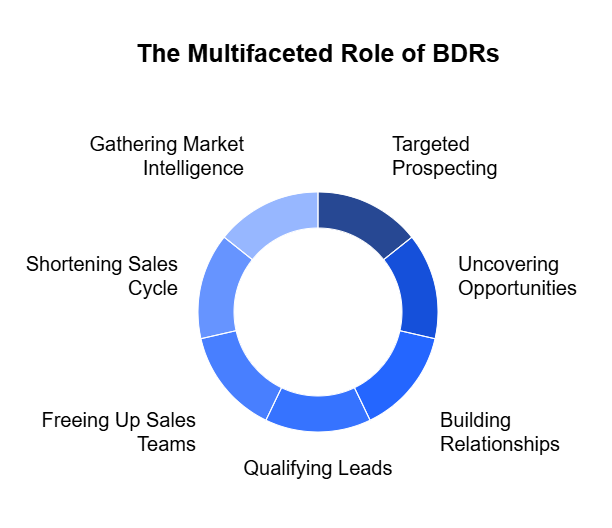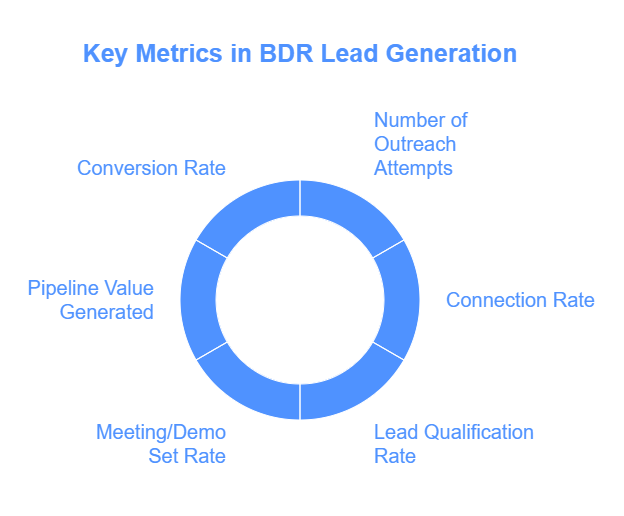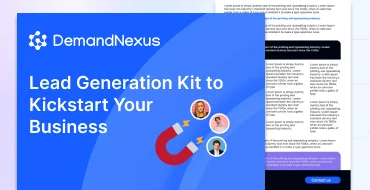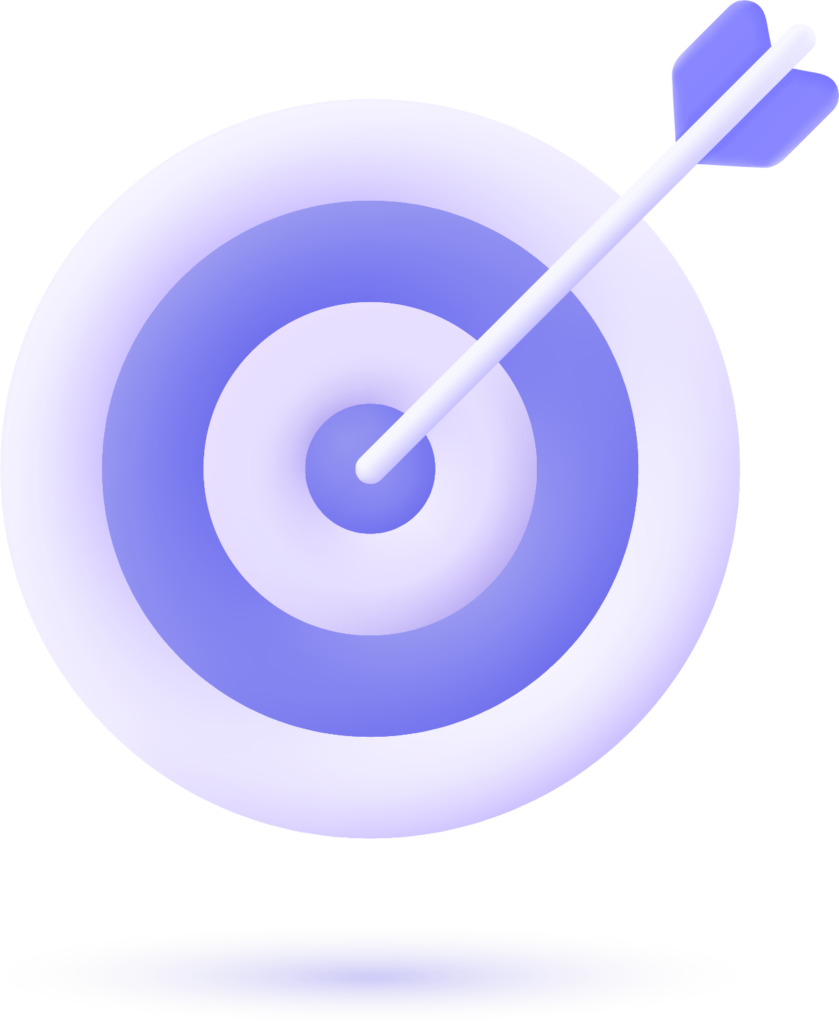In today’s fiercely competitive business landscape, relying solely on inbound marketing or passive lead generation is no longer a sustainable growth strategy. To truly accelerate your sales pipeline and capture untapped opportunities, a proactive and targeted approach is essential. This is where the power of Business Development Representative (BDR) lead generation comes into play.
BDRs are the frontline warriors of your sales engine, specializing in outbound prospecting and initiating contact with potential customers who might not even be aware of your solution yet. They are the catalysts that transform cold outreach into warm leads, setting the stage for your sales team to close deals and drive revenue.
This comprehensive guide will delve deep into the world of BDR lead generation, exploring its intricacies, benefits, essential strategies, and the critical skills required for success. We’ll uncover how a well-oiled BDR engine can revolutionize your sales process and propel your business to new heights.
Why BDR Lead Generation is a Game-Changer
While marketing efforts focus on attracting inbound leads through content, SEO, and social media, BDRs take a more direct and targeted approach. They actively seek out potential customers based on defined ideal customer profiles (ICPs) and initiate conversations. This proactive outreach offers several key advantages:
- Targeted Prospecting: BDRs focus their efforts on reaching out to companies and individuals that align perfectly with your target audience, ensuring a higher likelihood of conversion.
- Uncovering Hidden Opportunities: BDRs can tap into markets and identify potential customers that your marketing efforts might have missed, expanding your reach and market penetration.
- Building Initial Relationships: By initiating personalized conversations, BDRs can establish the first point of contact and begin building rapport with potential clients.
- Qualifying Leads Effectively: BDRs are trained to ask the right questions to understand a prospect’s needs, pain points, and budget, ensuring that only qualified leads are passed on to the sales team.
- Freeing Up Sales Teams: By handling the initial outreach and qualification, BDRs allow Account Executives (AEs) to focus on what they do best: nurturing qualified leads and closing deals.
- Faster Sales Cycle: A well-structured BDR process can significantly shorten the sales cycle by proactively identifying and qualifying potential customers.
- Gathering Market Intelligence: Through their interactions with prospects, BDRs gather valuable insights into market trends, customer needs, and competitor activities, which can inform your overall business strategy.

The BDR’s Role in Filling the Sales Funnel
Think of your sales funnel as a journey that potential customers take, from initial awareness to becoming loyal clients. BDRs play a crucial role in the very first stages of this journey:
Table 1: The BDR’s Place in the Sales Funnel
| Stage of Sales Funnel | Activities | Role of the BDR |
|---|---|---|
| Awareness | Potential customers become aware of a problem or need. | Identifies potential customers who fit the ICP and might have the problem your solution solves, even if they aren’t actively looking. |
| Interest | Potential customers start researching solutions to their problem. | Initiates contact, introduces your company and solution in a relevant way, and aims to pique their interest. |
| Consideration | Potential customers evaluate different solutions. | Provides initial information, answers basic questions, and qualifies the prospect based on their needs and fit. |
| Decision | Potential customers choose a solution. | Hands off qualified leads to Account Executives for demos, detailed presentations, and closing. |
| Action | Potential customers make a purchase. | (Indirectly contributes by ensuring a consistent flow of qualified leads) |
| Retention | Customers continue to use and potentially expand their relationship with you. | (Indirectly contributes by ensuring a healthy pipeline for future growth) |
Understanding the different stages of the B2B sales funnel is fundamental to appreciating the BDR’s crucial position in initiating this process.
Essential Strategies for Effective BDR Lead Generation
Building a successful BDR lead generation engine requires a strategic and multifaceted approach. Here are some key strategies to implement:
1. Define Your Ideal Customer Profile (ICP) with Precision
Before your BDRs start reaching out, you need a crystal-clear understanding of who your ideal customer is. This involves defining:
- Industry: Which industries are most likely to benefit from your solution?
- Company Size: What is the ideal revenue, employee count, or market capitalization of your target companies?
- Geography: Are there specific regions or locations you should focus on?
- Job Titles: Which roles within these organizations are the key decision-makers or influencers?
- Pain Points: What specific problems does your solution solve for these customers?
- Goals: What are their key business objectives that your solution can help them achieve?
The more detailed and accurate your ICP, the more targeted and effective your BDR outreach will be.
2. Equip Your BDRs with the Right Tools and Technology
To maximize their efficiency and effectiveness, BDRs need access to the right tools and technologies, including:
- Customer Relationship Management (CRM) System: A central platform to track leads, interactions, and progress. Popular options include Salesforce, HubSpot CRM, and Zoho CRM.
- Sales Intelligence Platforms: Tools like LinkedIn Sales Navigator, ZoomInfo, and Apollo.io provide valuable insights into companies and contacts, helping BDRs identify the right prospects.
- Email Outreach Tools: Platforms like Outreach, Salesloft, and Lemlist automate and personalize email sequences, track engagement, and ensure consistent follow-up.
- Calling Software: Tools with features like call recording, analytics, and integration with the CRM can enhance the effectiveness of cold calling efforts.
- Social Selling Platforms: Leveraging social media platforms, especially LinkedIn, for research, connection, and engagement is crucial for modern BDRs.
3. Craft Compelling Outreach Messaging
The success of BDR outreach hinges on the quality and relevance of the messaging. Generic or sales-y outreach is likely to be ignored. Instead, focus on:
- Personalization: Tailor your message to the specific prospect and their company, referencing their industry, recent news, or potential pain points.
- Value Proposition: Clearly articulate the value your solution offers and how it can address the prospect’s challenges or help them achieve their goals.
- Conciseness: Respect the prospect’s time and get straight to the point.
- Clear Call to Action: Tell the prospect exactly what you want them to do next, such as scheduling a brief call or requesting more information.
Example of a Personalized Cold Email Snippet:
Subject: Addressing [Specific Pain Point] at [Prospect’s Company]
Hi [Prospect Name],
I came across [Prospect’s Company] in the [Industry] sector, and I noticed [mention a relevant observation, e.g., your recent blog post on X, or a challenge common in their industry].
At [Your Company], we help businesses like yours [briefly explain your solution and its key benefit, e.g., reduce operational costs by streamlining Y].
Would you be open to a quick 15-minute chat next week to explore if [Your Company] could be a good fit for [Prospect’s Company]’s needs?
Best regards,
[Your Name]
4. Master the Art of Cold Calling
While often perceived as challenging, cold calling remains a powerful tool for BDRs when executed effectively. Understanding the nuances of cold calling vs. cold emailing can help BDRs choose the most appropriate outreach method for different scenarios. Key elements of successful cold calling include:
- Thorough Research: Understand the prospect’s company and role before picking up the phone.
- Compelling Opening: Grab their attention within the first few seconds with a relevant and value-driven statement.
- Active Listening: Pay close attention to the prospect’s responses and tailor the conversation accordingly.
- Handling Objections: Be prepared to address common objections professionally and confidently.
- Clear Next Steps: Always have a specific goal for the call, whether it’s scheduling a follow-up or gathering more information.
Table 2: Tips for Effective Cold Calling
| Tip | Description |
|---|---|
| Plan Your Calls | Outline your key talking points and potential questions beforehand. |
| Practice Your Pitch | Rehearse your opening and value proposition to sound natural and confident. |
| Be Enthusiastic | Your energy and positivity can be contagious. |
| Focus on Value | Emphasize how your solution can benefit the prospect, not just its features. |
| Ask Open-Ended Questions | Encourage the prospect to share more information about their needs and challenges. |
| Don’t Be Afraid of “No” | Rejection is part of the process. Learn from it and move on. |
| Follow Up Diligently | If a prospect expresses interest, ensure you follow up promptly with the agreed-upon information. |
5. Leverage Social Selling
Social media platforms, particularly LinkedIn, offer valuable opportunities for BDRs to:
- Research Prospects: Gain deeper insights into their professional backgrounds, interests, and company activities.
- Identify Connections: See if you have any mutual connections who can provide an introduction.
- Engage with Content: Like, comment on, and share relevant content to build rapport and establish yourself as a knowledgeable resource.
- Send Personalized Messages: Initiate conversations with targeted prospects in a less intrusive way than cold email or calls.
6. Implement Effective Lead Qualification Processes
Not every prospect your BDRs interact with will be a good fit for your solution. Implementing a robust lead qualification process is crucial to ensure that your sales team focuses on the most promising opportunities. Understanding the difference between cold, warm, and hot leads is essential for effective qualification. This involves defining specific criteria that indicate a lead’s potential, such as:
- Need: Does the prospect have a problem that your solution can solve?
- Authority: Does the prospect have the authority to make or influence purchasing decisions?
- Budget: Does the prospect’s company have the financial resources to invest in your solution?
- Timeline: What is the prospect’s timeframe for implementing a solution?
BDRs should be trained to ask qualifying questions and accurately assess leads based on these criteria.
7. Provide Ongoing Training and Coaching
The landscape of sales and lead generation is constantly evolving. To ensure your BDR team remains effective, invest in ongoing training and coaching on:
- Product Knowledge: Deep understanding of your company’s products or services.
- Sales Skills: Effective communication, active listening, objection handling, and closing techniques.
- Tools and Technology: Best practices for utilizing the CRM, sales intelligence platforms, and outreach tools.
- Industry Trends: Staying up-to-date on the latest market developments and customer needs.
Regular coaching sessions can help BDRs refine their skills, address challenges, and stay motivated.
8. Foster Strong Collaboration Between BDRs and Sales Teams
Seamless communication and collaboration between BDRs and Account Executives are essential for a smooth and efficient sales process. BDRs should provide AEs with detailed information about the qualified leads they hand off, including their needs, pain points, and any relevant context from their initial conversations. Regular feedback loops between the two teams can help optimize the entire lead generation and sales process. To ensure this collaboration is effective, a well-defined B2B sales team structure is often beneficial.
9. Track Key Metrics and Analyze Performance
To measure the success of your BDR lead generation efforts and identify areas for improvement, it’s crucial to track key performance indicators (KPIs). By monitoring relevant B2B sales KPIs, you can gain insights into the effectiveness of your BDR strategies and make data-driven decisions. Examples of important metrics include:
- Number of Outreach Attempts (Emails, Calls, Social Touches): Measures the activity level of your BDR team.
- Connection Rate: Percentage of outreach attempts that result in a meaningful interaction.
- Lead Qualification Rate: Percentage of interactions that result in a qualified lead.
- Meeting/Demo Set Rate: Number of qualified leads that are scheduled for a meeting or demo with an AE.
- Pipeline Value Generated: The potential revenue value of the leads generated by the BDR team.
- Conversion Rate (BDR-Generated Leads to Closed Deals): The ultimate measure of the effectiveness of BDR efforts.

Regularly analyzing these metrics will provide valuable insights into what’s working well and where adjustments need to be made. Understanding how to generate sales leads effectively is directly tied to tracking these metrics and optimizing your approach.
10. Continuously Optimize Your Lead Generation Process
The most successful BDR lead generation engines are constantly being refined and optimized. Regularly review your ICP, outreach messaging, qualification criteria, and performance metrics to identify areas for improvement. A/B test different approaches to see what resonates best with your target audience.
The Skills That Make a BDR Lead Generation Superstar
While strategies and tools are important, the success of your BDR team ultimately comes down to the skills and qualities of the individuals in those roles. Top-performing BDRs typically possess:
- Resilience: The ability to handle rejection and stay motivated despite facing numerous “no’s.”
- Empathy: The capacity to understand the prospect’s perspective and tailor their approach accordingly.
- Communication Skills: Excellent verbal and written communication skills to articulate value clearly and persuasively.
- Curiosity: A genuine desire to learn about the prospect’s business and industry.
- Creativity: The ability to think outside the box and find innovative ways to engage prospects.
- Organization: Strong organizational skills to manage their outreach efforts and follow up effectively.
- Goal-Oriented: A strong drive to achieve targets and contribute to the company’s growth.
- Active Listening: The ability to truly hear and understand the prospect’s needs and concerns.
Outsourcing BDR Lead Generation: A Strategic Option
Building and managing an in-house BDR team requires significant investment in recruitment, training, technology, and ongoing management. For some businesses, outsourcing BDR lead generation to a specialized firm can be a more efficient and cost-effective option.
Benefits of Outsourcing BDR Lead Generation:
- Access to Expertise: Partner with experienced BDR professionals who have a proven track record of success.
- Faster Ramp-Up Time: Avoid the lengthy hiring and training process associated with building an internal team.
- Cost-Effectiveness: Potentially lower overall costs compared to salaries, benefits, and overhead of an in-house team.
- Scalability: Easily scale your BDR efforts up or down based on your business needs.
- Focus on Core Competencies: Allow your internal teams to focus on their core strengths.

DemandNexus: Your Partner in BDR Lead Generation Excellence
At DemandNexus, we understand the intricacies of effective BDR lead generation. Our team of experienced professionals leverages cutting-edge tools and proven strategies to identify, engage, and qualify high-potential leads for your business. We act as an extension of your sales team, dedicated to fueling your pipeline and driving revenue growth. Our expertise in crafting personalized outreach, mastering cold calling techniques, and implementing robust qualification processes ensures that you receive a consistent flow of sales-ready leads.
We work closely with you to understand your ideal customer profile and tailor our approach to your specific business objectives. By partnering with DemandNexus, you can accelerate your lead generation efforts, free up your sales team to focus on closing deals, and ultimately achieve your growth targets.
Conclusion: Fueling Growth with Strategic BDR Lead Generation
In today’s dynamic business environment, proactive lead generation is no longer a luxury – it’s a necessity for sustained growth. By strategically implementing BDR lead generation, you can unlock untapped opportunities, build a robust sales pipeline, and ultimately drive significant revenue. Whether you choose to build an in-house team or partner with experts like DemandNexus, investing in a well-defined and effectively executed BDR strategy is a crucial step towards achieving your business goals. Embrace the power of proactive outreach and watch your sales pipeline flourish.



